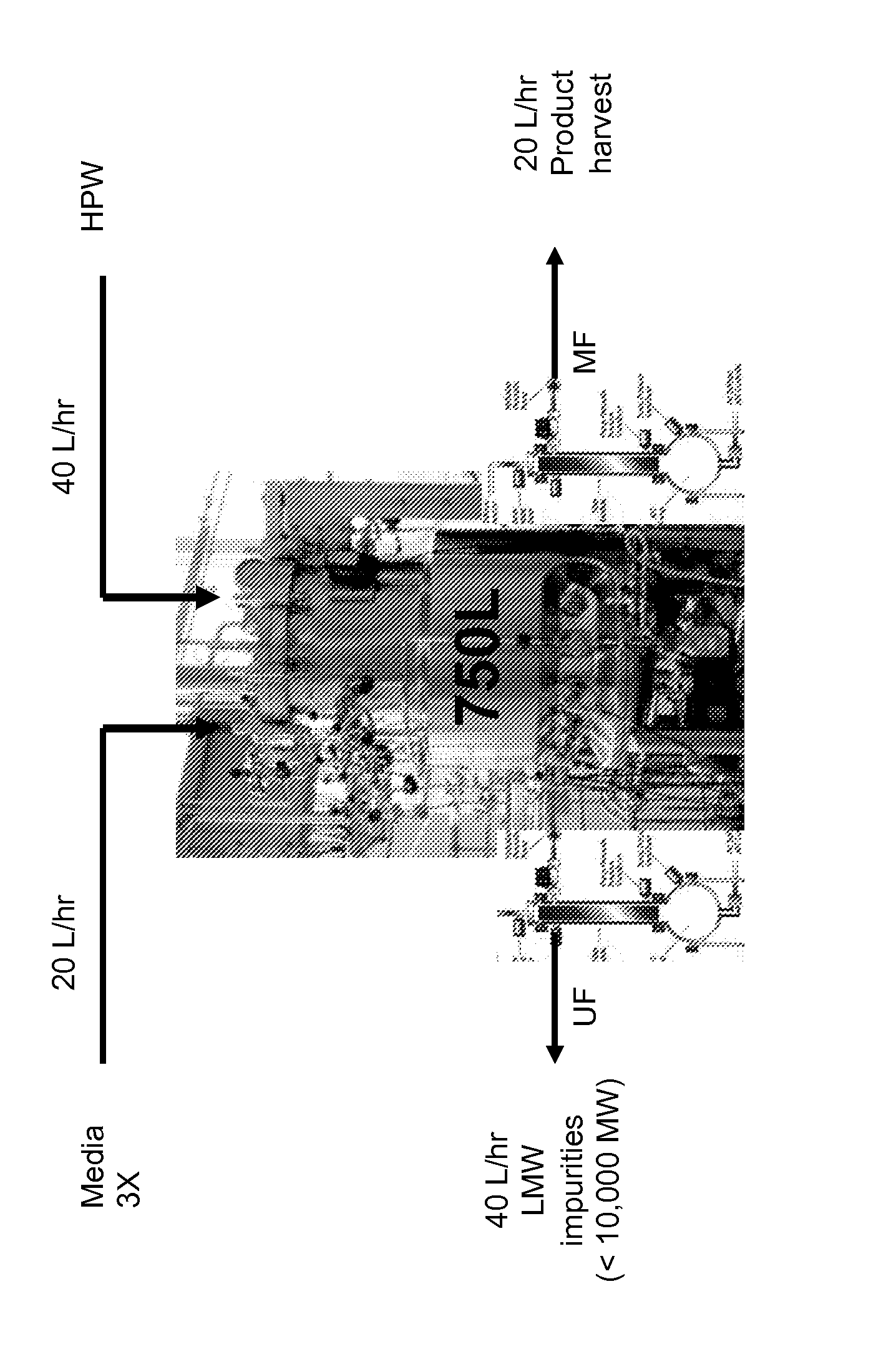Method for producing a biopolymer (e.g. polypeptide) in a continuous fermentation process
a technology of continuous fermentation and biopolymer, which is applied in the field of producing a biopolymer, can solve the problems of high cost, low production efficiency, and low process efficiency, and achieve the effect of improving cell viability and cell density
- Summary
- Abstract
- Description
- Claims
- Application Information
AI Technical Summary
Benefits of technology
Problems solved by technology
Method used
Image
Examples
example 1
1. A 100 L working volume bioreactor with 50 L of Ex-cell media is inoculated with 15 L of CHO-K1 expressing an IgG antibody.
[0085]The system is equipped with an ATF 6 module with a 0.45 micron membrane (product filter) for the product harvest and an ATF 6 module with a 10.000 NMWC membrane (impurity filter) for the low molecular perfusion. After one week of expansion and 5 days of product fermentation the cell density reaches around 15 mill cells / ml in a working volume of 100 L—the starting criteria for use of harvest for downstream processing.
[0086]2. The bioreactor is fed with 150 L of media per day to the 100 L working volume and a steady state is obtained after 10 days of harvest with a viable cell concentration of around 30 mill cells / ml and a productivity of around 45 gram antibody per day is obtained. Antibody concentration in the harvest stream is around 300 mg / L. All added media perfuse out through the product filter.
3. At harvest day 10 the ATF 10.000 NMWC is started and ...
example 2
[0090]Example 1 above is repeated with the only difference that in step 3; 6 L / hr is perfusing out of the 10,000 NMWC ATF and 2 L / hr is perfusing as product harvest out of the 0.45 micron ATF.
[0091]The result was that the product accumulation in the harvest stream is increased from around 850 mg / L to around 1250 mg / L by operating the liquid out flow through the impurity filter at three times the rate as the liquid out flow through the product filter.
example 3
[0092]Example 1 above is repeated with the only difference that in step 3 the ATF 10.000 NMWC (impurity filter) is not operating, and all 8 L / hr added media is harvest out of the 0.45 micron ATF (product filter).
[0093]At day 20 the system is stabilized at a viable cell density of around 45 mill cells / ml and reached a productivity of around 60 gram per day. The antibody concentration in the harvest is at the same time decreased to around 425 mg / L.
[0094]This demonstrates that using the impurity filter in step 3 improved both cell density and product yield.
PUM
| Property | Measurement | Unit |
|---|---|---|
| molecular weight | aaaaa | aaaaa |
| molecular weight | aaaaa | aaaaa |
| pore size | aaaaa | aaaaa |
Abstract
Description
Claims
Application Information
 Login to View More
Login to View More - R&D
- Intellectual Property
- Life Sciences
- Materials
- Tech Scout
- Unparalleled Data Quality
- Higher Quality Content
- 60% Fewer Hallucinations
Browse by: Latest US Patents, China's latest patents, Technical Efficacy Thesaurus, Application Domain, Technology Topic, Popular Technical Reports.
© 2025 PatSnap. All rights reserved.Legal|Privacy policy|Modern Slavery Act Transparency Statement|Sitemap|About US| Contact US: help@patsnap.com

